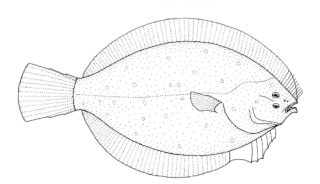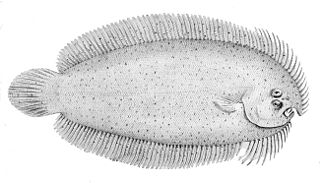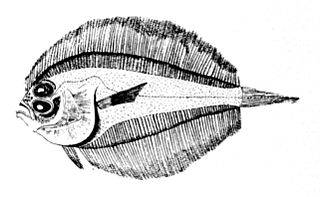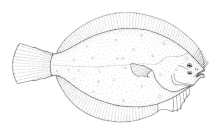
Citharichthys is a genus of flatfish in the large-tooth flounder family, Paralichthyidae. They have both eyes on the left sides of their heads. They are native to the oceans around the Americas, with a single species, C. stampflii off the West African coast. Most are found in relatively shallow depths, but the genus also includes species found in deep water and species that enter fresh water.

Pleuronectidae, also known as righteye flounders, are a family of flounders. They are called "righteye flounders" because most species lie on the sea bottom on their left sides, with both eyes on their right sides. The Paralichthyidae are the opposite, with their eyes on the left side. A small number of species in Pleuronectidae can also have their eyes on the left side, notably the members of the genus Platichthys.

The black flounder is a flatfish of the genus Rhombosolea, found around New Zealand in shallow enclosed waters and coastal freshwater lakes. Its adult length ranges from 20 to 45 cm.

The yellowbelly flounder is a flatfish of the genus Rhombosolea, found around New Zealand. A different species from the genus Rhombosolea is found in Australia and also goes by the name yellow-belly flounder. The Māori people have commonly fished for R.leporina, and many other species of flatfish, throughout New Zealand's coastal waters for hundreds of years. The Māori name for this species is 'patiki totara'.

Theraps is a genus from the cichlid fish found in Atlantic slope rivers of southern Mexico and northern Central America. They are relatively elongate, medium-sized cichlids.

Pseudopleuronectes is a genus of righteye flounders mostly native to the northwestern Pacific Ocean with one species found in the northwestern Atlantic Ocean.
Nematops is a genus of righteye flounders native to the Indo-West Pacific. Due to their small size and depth of habitation few examples of this genus are caught, and as a result little is known of their morphology and distribution.

Poecilopsetta is a genus of small righteye flounders mainly found in deep water in the Indo-Pacific. Two species, P. beanii and P. inermis, are from the West Atlantic.

Ammotretis is a genus of righteye flounders native to the coastal waters off southern Australia.

Peltorhamphus is a genus of righteye flounders native to the southwest Pacific Ocean around New Zealand and Norfolk Island (Australia).

The Citharidae or largescale flounders are a small family of flounders with four genera. Three genera are restricted to the Indo-Pacific, while Citharus is from the Mediterranean and East Atlantic. There are a total of seven species. Species reach lengths ranging between 14 and 36 centimetres.

Bothus is a genus of flatfish in the family Bothidae from the Pacific, Indian and Atlantic Oceans. Some species in this genus have spots consisting of blue rings.

The scaldfishes comprise a genus, Arnoglossus, of lefteye flounders. They are found in the Pacific, Indian and Atlantic Oceans, including the Mediterranean and Black Sea. They are entirely absent from most of the Americas; the only exceptions are A. coeruleosticta and A. multirastris found off Chile. The genus include both species found in shallow and deeper water. The largest species reaches 28 cm (11 in).

Laeops is a genus of small lefteye flounders from the Indo-Pacific. They are mainly found in deep water, although a few species have been recorded shallower than 100 m (330 ft).

Lophonectes is a genus of small lefteye flounders found in the southwestern Pacific Ocean off Australia and New Zealand.

Taeniopsetta is a genus of small lefteye flounders native to the Indo-Pacific at depths of 150 to 300 m.

Paralichthys is a genus of large-tooth flounders. Most species are native to the coastal waters of the Americas, but P. olivaceus is from northeast Asia. The largest species reaches about 1.5 m (5 ft) in length.

Pseudorhombus is a genus of large-tooth flounders. With the exception of P. binii found off Peru, species in this genus are native to the Indo-Pacific. The largest species reaches 40 cm (16 in) in length.

Syacium is a genus of large-tooth flounders found in the Atlantic and Pacific Oceans. With the exception of S. guineensis from the Atlantic coast of Africa, all species are from the Americas. The largest species in the genus reaches 40 cm (16 in) in length.


















